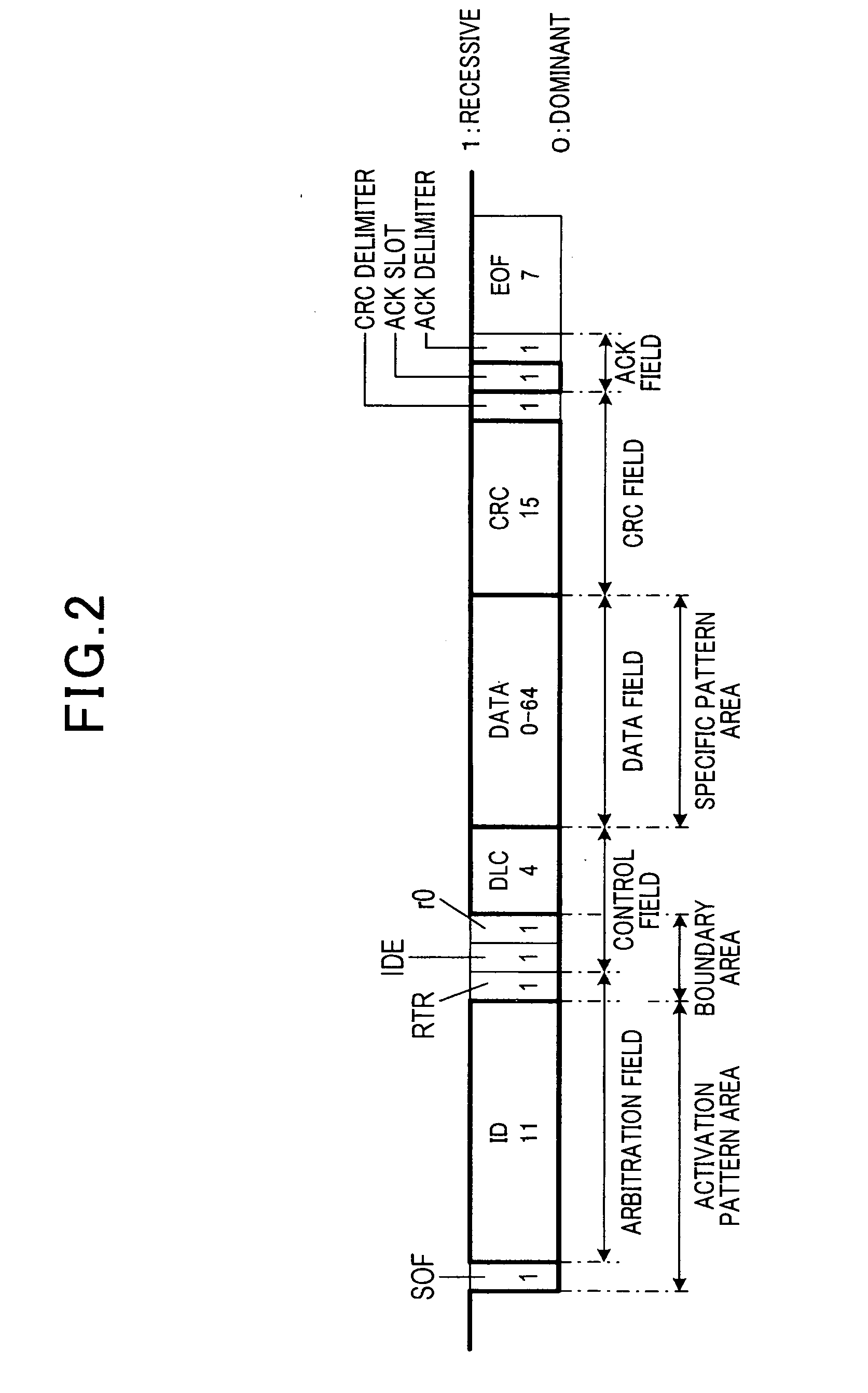Communication system with a plurality of nodes communicably connected for communication based on NRZ (non return to zero) code
a communication system and plurality of nodes technology, applied in the field of communication networks, can solve the problems of unignorable electric power consumption, inability to exclusively wake up and use necessary nodes, and inability to communicate system-wide, etc., and achieve the effect of increasing the power consumption of nodes
- Summary
- Abstract
- Description
- Claims
- Application Information
AI Technical Summary
Benefits of technology
Problems solved by technology
Method used
Image
Examples
first embodiment
[0065]With reference to FIGS. 1-12, a first embodiment will now be described.
[0066]FIG. 1 is a block diagram illustrating an on-vehicle configuration of a communication system 1 that uses a CAN (Controller Area Network) protocol as a communication protocol.
[0067]As shown in FIG. 1, the communication system 1 is configured connecting a plurality of electronic control units 10a, 10b, 10c, . . . installed in a vehicle via a common communication channel LN so that the electronic control units can communicate with each other. In the communication system 1, each of these electronic control units 10a, 10b, 10c, . . . functions as a node. In the description set forth below, these electronic control units are referred to as “ECUs 10a, 10b, 10c, . . . ”. Further, when one or some of these ECUs 10a, 10b, 10c, . . . is / are mentioned without particularly indicating specific reference numerals, or mentioned as representative(s), the ECU(s) is / are referred to as “ECU(s) 10”.
[0068]The communication...
second embodiment
[0173]Referring to FIGS. 13-19, a second embodiment of the present invention will now be described.
[0174]It should be appreciated that in the second and subsequent embodiments, the component identical with or similar to those in the first embodiment are given the same reference numerals for the sake of omitting unnecessary explanation. In addition, the explanation in the second and subsequent embodiments will be done mainly for parts different from those in the first embodiment.
[0175]The second embodiment is different from the first embodiment only in the ID used for activation and a part of the configuration of the activation pattern determination circuit 22. The description set forth below is given focusing on the differences.
[0176]A portion (SOF and ID) of the activation pattern area of an activation frame is expressed by 11111(0)11111(0)1, where indicates SOF and (0) indicates a stuff bit. Thus, when ID=0x7FF is established, with a boundary condition being that an area having t...
third embodiment
[0229]With reference to FIGS. 20-23, hereinafter is described a third embodiment of the invention.
[0230]The present embodiment uses a data frame as an activation frame in which ID is set to 0x078. In other words, use of this ID is inhibited in the communication between the ECUs 10 whose operational mode is a normal mode.
[0231]The activation pattern area of the activation frame is expressed with bit patterns as: [0][0000(1)1111(0)00][0(1)00]. The first square brackets indicate SOF, the second square brackets indicate ID and the third square brackets indicate RTR, IDE and R0. Also, (0) and (1) indicate stuff bits.
[0232]This ID (=0x078) is a sole unique bit pattern in which each edge at which a receptive level turns to a dominant level is used as an edge of focus, and a bit length from the head (start timing) to the third edge of focus (end timing) is maximized (16 bits). From a different point of view, this ID is a sole unique bit pattern in which the number of edges of focus detected...
PUM
 Login to View More
Login to View More Abstract
Description
Claims
Application Information
 Login to View More
Login to View More - R&D
- Intellectual Property
- Life Sciences
- Materials
- Tech Scout
- Unparalleled Data Quality
- Higher Quality Content
- 60% Fewer Hallucinations
Browse by: Latest US Patents, China's latest patents, Technical Efficacy Thesaurus, Application Domain, Technology Topic, Popular Technical Reports.
© 2025 PatSnap. All rights reserved.Legal|Privacy policy|Modern Slavery Act Transparency Statement|Sitemap|About US| Contact US: help@patsnap.com



